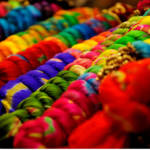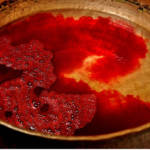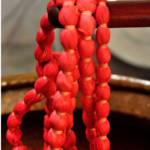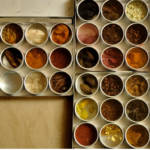Tie and Dye
Communities of dyers from Bagru are settled in the city and trade in cloth. The area specializes in a distinct shade of indigo dye for cotton textile. It is at this stage when mud resist dyeing techniques which employ the use of black mud that resists the dye, lime water that prevents cracking in the mud paste applied to the cloth and wheat powder that improves the adhesion quality. Resist dyeing techniques have been used to create elaborate patterns especially in the Bagru region, a short drive from Jaipur.
Jaipur is also famous for the tie and dye cottage industry. Lehriya and bandhini being the most famous prints. In bandhini, the cloth is pinched in small areas and tied together repeatedly to create the iconic bhandini dots. These dots can be tied in a different configuration to create a series of designs like the Chandrakala, Bavan Baug, Shikari. In lehriya, the cloth is pleated from diagonal corners and tied together at intervals to create wave-like patterns, giving the style its distinct name.




